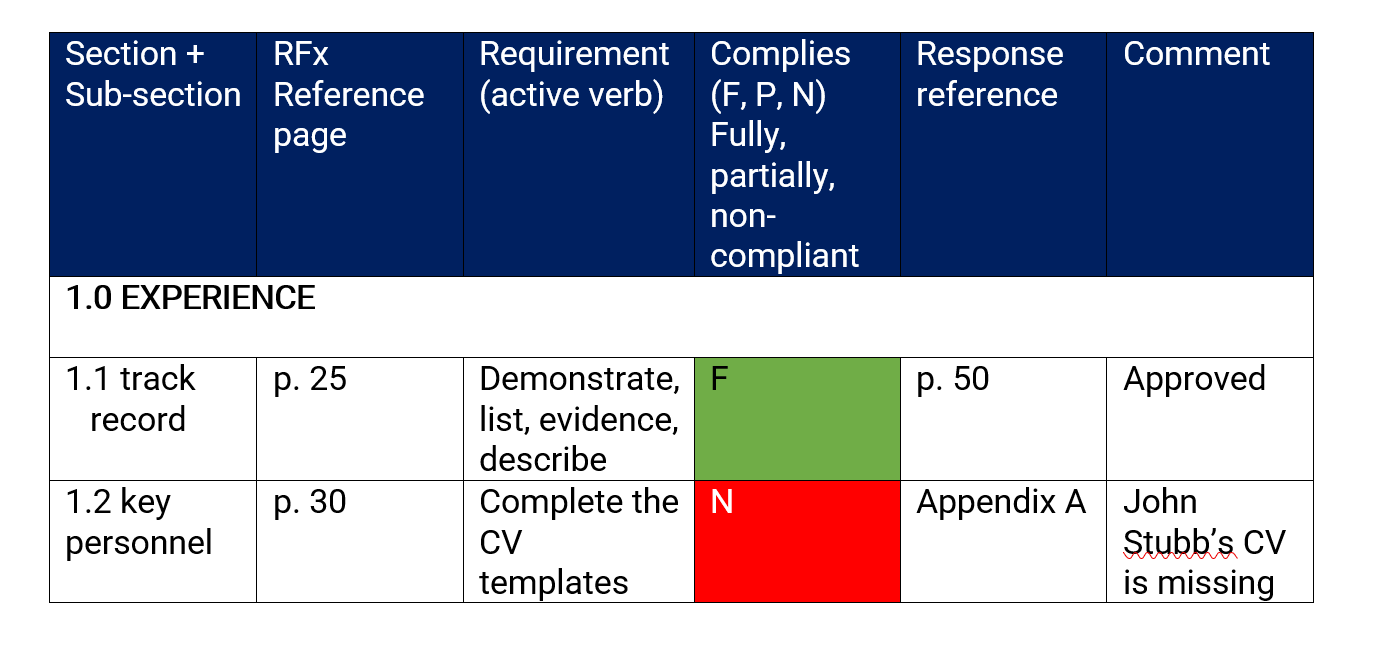Planning your Bid Response – RFP template set up
Why is it important?
Developing a bid response is very time consuming and usually high pressure work that involves large amounts of documentation and numerous content contributors. Timeframes are being increasingly compressed while documentation has become increasingly complex.
A bid response is a project in itself, so applying project management principles is a critical success factor for bid development regardless of the contract or team size.
Proven and repeatable processes, collaboration and supporting tools and technology are key elements of effective bid teams
For this reason the bid response should not be a reactive set of activities to a given scope of work or the ‘price.’ Suppliers are now expected to articulate their value proposition with clear understanding of why goods, services and works are being procured; the context in which they are being procured; and demonstrating an understanding of communities affected by the procurement.
All of this takes planning, research and analysis, and strategic development. Naturally, the proposal planning stage requires executive commitment, a committed project team and bid lead, project management tools, and strong communication and coordination skills.
Plan proposal objectives
The purpose of the proposal planning stage is to:
- Understand the requirements: Gather documentation and RFx intelligence to determine what needs to be done, by whom, in what format, and when
- Bid strategy: Develop an agreed bid strategy with win themes and discriminators
- Logistics and governance: Develop a project schedule for stakeholder and subject matter expert input (technical, commercial, legal), including decision gates, and review and approval milestones
- Develop the proposal outline: Set up the proposal template and collate documentation with summary information and guidance for the writing team.
Essential tools
- Content Library
- Bid Schedule
- Response Template
- Compliance & Risk Matrix
Getting organised
For the broader bid team often one of first reality checks in the bidding process is receiving the RFx. This is the finite window for putting the response together.
This stage requires attention to detail to understand the customer requirements and goals, deconstruct the evaluation criteria (what are they really asking for), juggling priorities and co-dependencies, and pulling together as a motivated, high performing team to meet the deadline and mandatory content and compliance requirements.
Before you circulate the RFx documentation in preparation of your bid response you will need to decide and communicate:
- Who is project managing the bid?
- Who is gathering information and doing research?
- Who is co-ordinating and disseminating all the material you need?
- Who is writing the drafts?
- Who is reviewing them?
- How will the rest of your organisation’s work get done?
Proven and repeatable processes, collaboration and supporting tools and technology to centralise and align people and their intellectual knowledge assets are key elements of effective bid teams.
The RFP Template and Proposal Plan
The RFP Template and Proposal Plan helps the team to remain focused on the three most critical aspects of your proposal:
- Preparation – Any instructions or rules relating to the procurement process
- Submission – The mandatory criteria and compliance requirements that you need to address in your submission
- Evaluation – The assigned weightings against the statement of work or specification and other criteria upon which you will be assessed (or evaluated) against your competition.
The proposal planning process is often led by the Bid or Proposal Manager based on information provided in a capture plan and the issued RFx documentation. For larger proposals, deconstructing the response into a Compliance Matrix ensures the response addresses and/or conforms to every instruction and requirement.
The Proposal Plan should include:
- A draft outline of the response
- A schedule for completing the response
- A Writers’ Package, and
- Clearly allocated roles and responsibilities.
Traditionally proposal planning has occurred across multiple documents and static templates. Despite the good intentions of Bid Managers attempting to set up and plan a bid for success, for many non-bid team members the sheer overwhelm of instructions, tables and cross-referencing can unfortunately lead to confusion or worse, non-conformance.
Bidhive helps to bring all of the many moving parts of the bid process into once seamless flow, and reducing the need to duplicate or provide overlapping instructions.
The writers’ package checklist
Thorough planning at this stage of the bid process is key, and a checklist can help you get ‘bid ready”.
The Writer’s Package should be distributed to anyone working on the response and include background information on the opportunity, the capture plan, the RFx documents supplied by the customer and any details relating to the procedure and rules of the bid.
A corporate language and graphics style guide can also be provided.
The Writer’s Package can also include contact details of any team members the writers will need to work with, and any evidence or data requirements that they need to gather or manage (this will either be identified as being available in the Content Library, or required to be sourced as new information).
Below is an example of a writer’s package checklist.
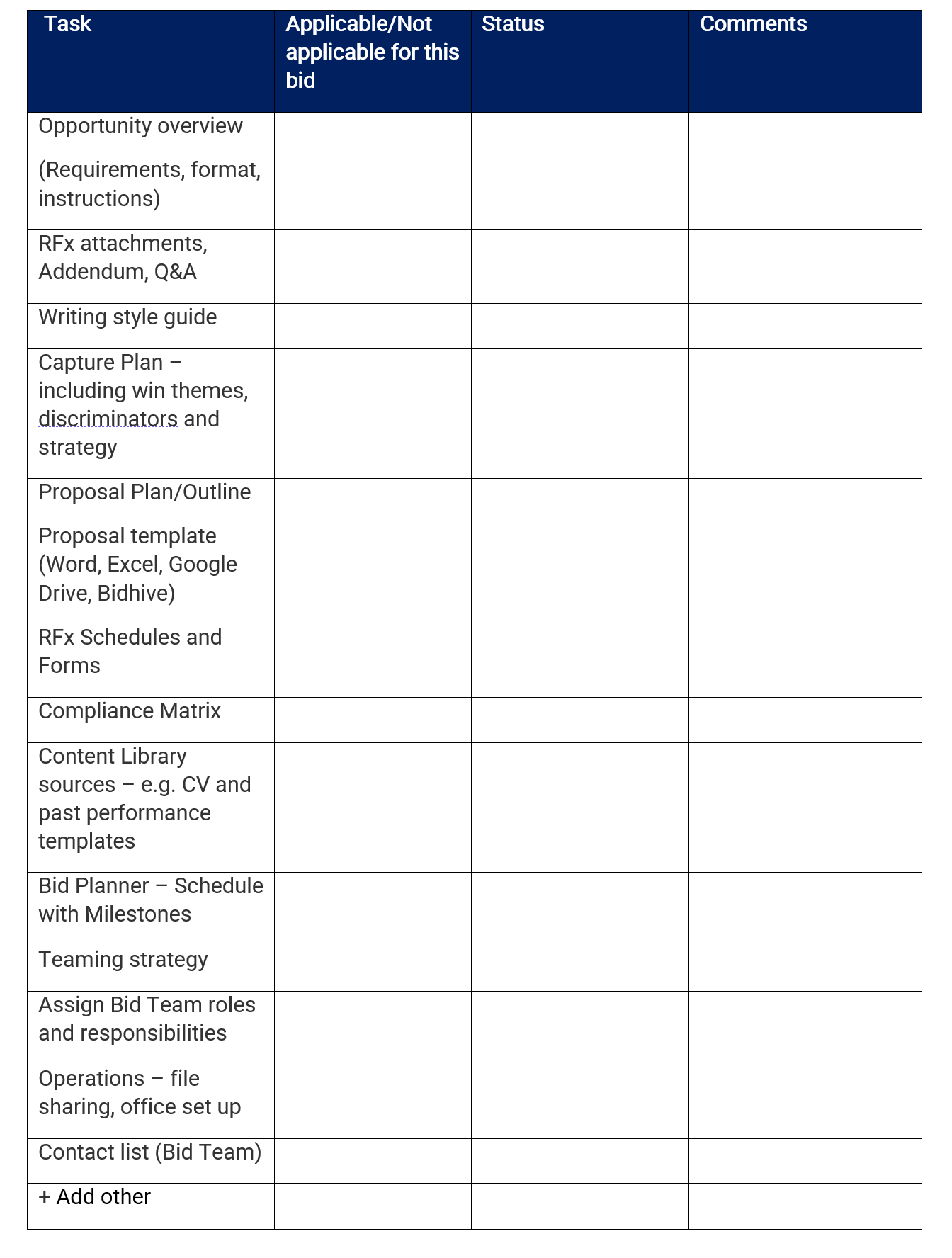
Content library

In our course on How to Build a Content Library we guide you through building your bid content and knowledge library structure and baseline content. The benefits of building this central source of truth for your company goes beyond just bidding.
It provides insight into the criteria commonly evaluated as important in your industry, and it serves as a good source of knowledge for training less experienced bid team members or new employees.
Structuring your content library by categories also ensures that responses can be broadened and tailored to a range of evaluation criteria rather than being limited to a select few answers that may be too narrow, or which could quickly become too broad and difficult to identify
While there is no universal or one-size-fits-all list of categories, by structuring your baseline content into categories relevant to your organisation you will have a logical way to search for, manage and update your information.
With your Content Library pre-prepared and continually evolving based on feedback and lessons learned, as well as global procurement trends, you’ll be able to re-focus your time and resources on strategy and continuous improvement.
Setting up the bid schedule
The Bid Schedule provides the Bid Manager, writers and contributors with a disciplined, yet flexible, framework for planning, developing and reviewing proposal requirements incrementally and sequentially.
Set milestone dates
If you have haven’t already registered the Opportunity in your Bid Opportunity Management system you can now prepare the bid timeline. Key customer dates will be published in the RFx document and typically includes:
- Release date of the RFx
- Close date for receipt of potential bidder questions
- Date that response to questions will be distributed to all bidders
- Last day to submit proposal (take note of the close date and time – especially time zone)
- Evaluation period (including possible invitation to present)
- Award date
- Contract commencement date.
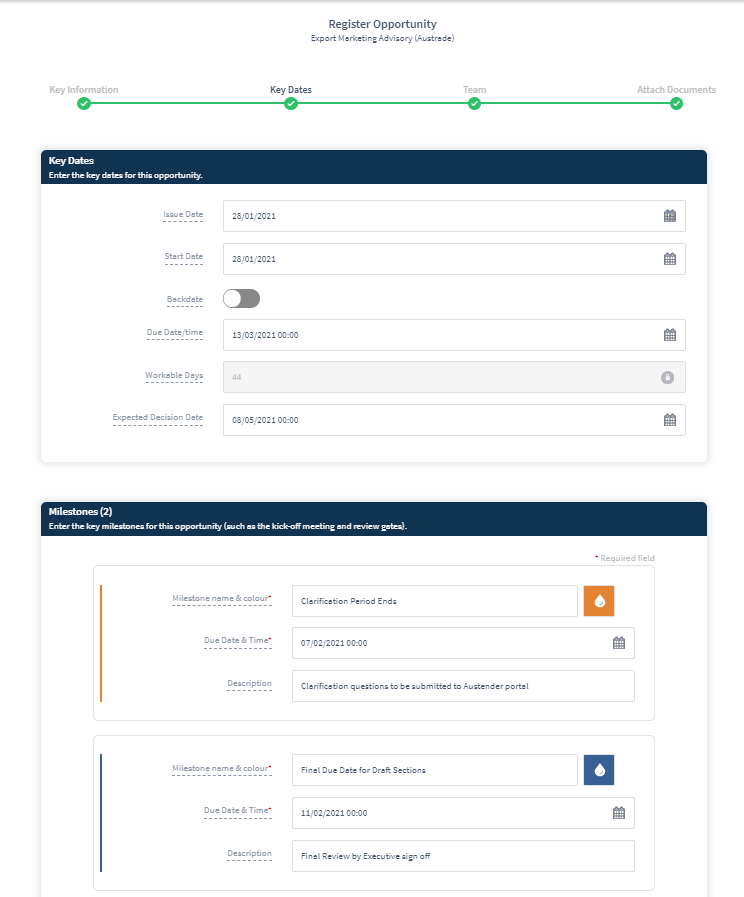
Identify your bid team (who will manage, who will provide subject matter expertise, who will review/approve). Add to your bid timeline internal governance and approval milestone dates.
While governance is important, agility is too! Not every milestone has to be formal or bureaucratic, and gates at phase transitions will largely be determined by the stage of the bid and/or the complexity of the deal. Being flexible, keeping lines of communication open and respecting your team’s many juggling priorities is the key to successful team dynamics.
Decision gates
In our Bid/No Bid lesson we introduced different stages of qualification. In your Bidhive you can allocate dates and colours to each of your milestones. For example, if you have a decision gate review process you could set up your Opportunity in Bidhive as follows:
- Opportunity Identification (purple)
- Qualification / Pursuit (blue)
- Preliminary Bid/No Bid (black)
- Bid Decision Validation (pink)
Colour reviews
By now you are fully aware of the complexity of bid practices, including the terminology and the many inputs and outputs involved – but the complexity can be minimised with repeatable processes that provide clarity around structure and governance.
The process of setting up your review process is another important aspect given as there are legal, commercial and technical considerations involved in a bid, and the slightest error or oversight could cost you lost evaluation marks and worse, potential disqualification for non-compliance.
To manage this complexity it has become standard practice in business development to conduct what’s been adopted by industry as the ‘proposal colour review’ process. Depending on your school of thought, colour reviews can be referred to as:
- Blue review, pink review, red review, gold review, white glove review, or
- Black hat, green team, blue team reviews, or
- Any combination of the above.
It doesn’t actually matter what your review schema is called. The main thing to understand is that the process serves the same purpose – that is, it’s about improving the quality of your competitive response by breaking down the process into a logical, step by step milestones for incremental review.
A project management Gantt chart is a helpful tool to communicate the timeline, and identifying and managing milestones.
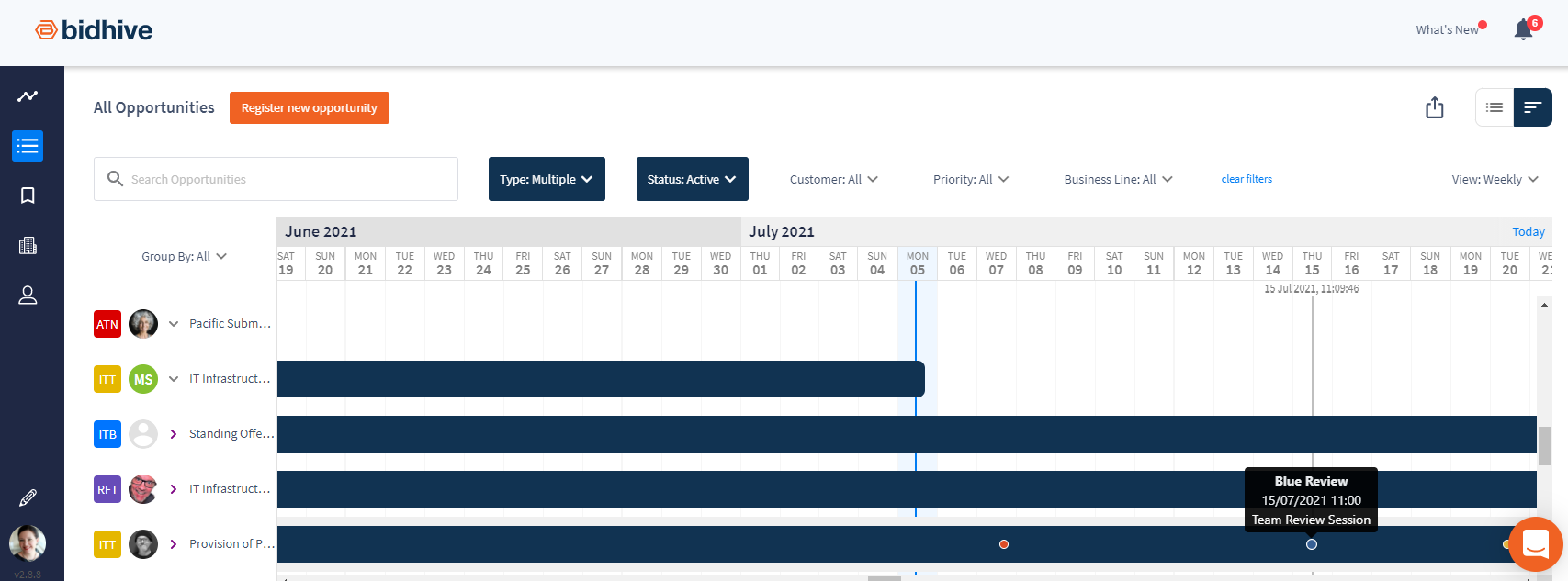
We’ll cover proposal colour reviews in more detail in our lesson on Proposal Development.
Response template
Regardless of whether your submission is simple or complex, the response template is the core piece in the development of the team’s responses to the RFx. It is usually developed as soon as the RFx is released, with the Kick off Meeting timed shortly after. The first step to preparing the response template is to understand the documentation provided by the customer.
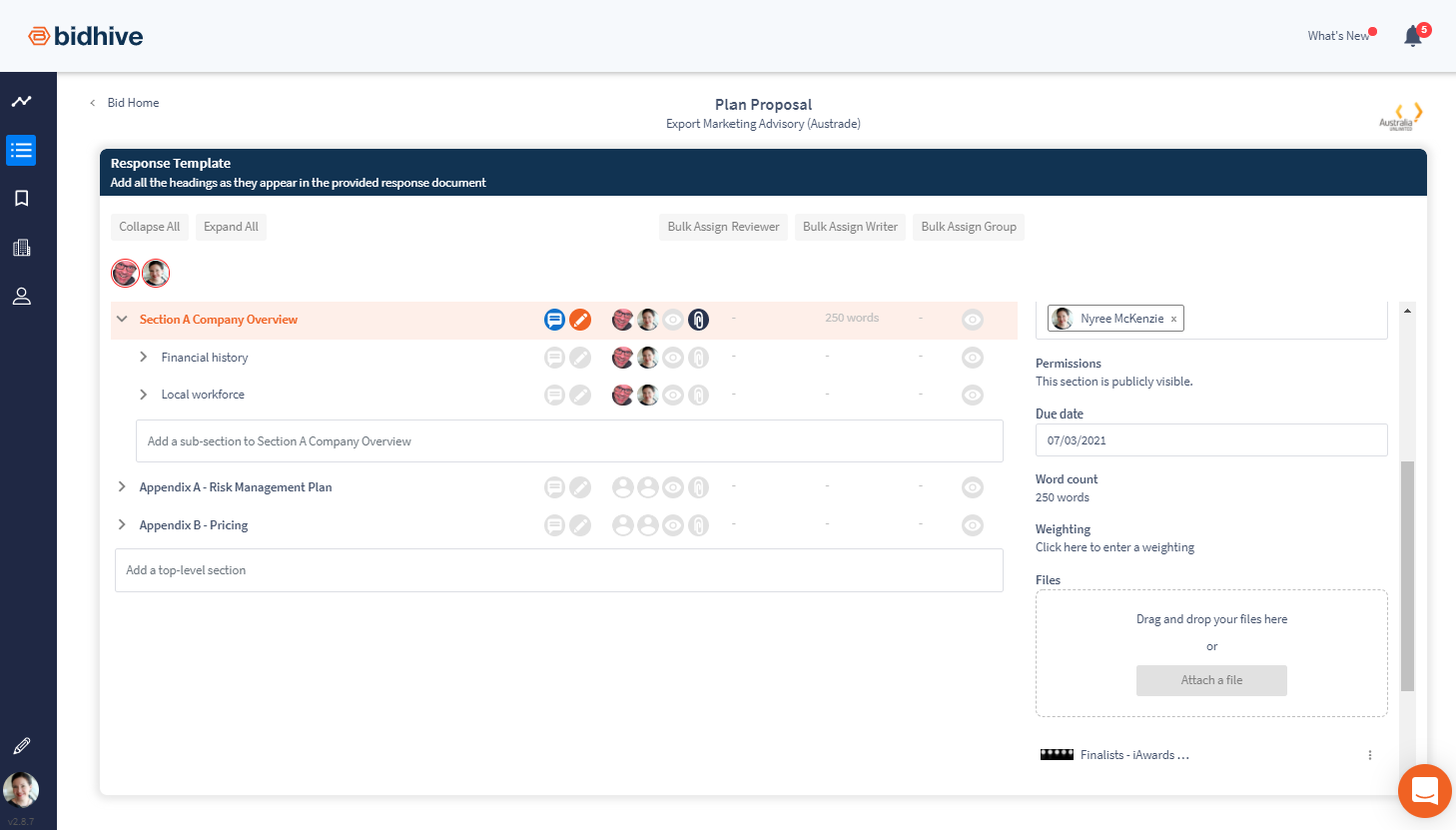
Before you commence setting up your template be sure to read all of the RFx requirements and scope of work. Contained within each section will be instructions on what to answer, and in what format to provide the response.
Reviewing the mandatory criteria and inclusions is vital at this point to allow for early identification of compliance requirements (such as Letters of Support, MoUs, Project or Transition Plans and other bespoke attachments that need forward planning and sufficient time allocation).
It is vital that you include these details in your writing plan to ensure everyone on the team is as prepared as possible.
TIP: Understanding the specifications
Spend some time up front to decipher the specifications and response requirements so that you can:
-
Understand the work effort that will be involved in developing a response
-
Start setting up the document template
-
Identify the most appropriate team members to assemble for the bid response; as well as the team members to nominate for the contract deliverables
-
Identify content requirements and assist the bid team to devise the most strategic and appropriate answers
-
Commence researching relevant past content that can be re-used or repurposed as a starting point for the submission.
Read the instructions
Step 1. Read all of the RFx and Conditions of Contract that will govern the preparation, submission and evaluation of the bid, noting any important background information or mandatory instructions to ensure a compliant proposal.
An example of an instruction is as follows (hint – look for the words must and should)
Eg. The bidder must comply with the following requirements:
The bidder must be prepared using a minimum font size of Arial 10 (other than for drawings or diagrams).
If the Tender is submitted in electronic format then the bidder must provide 1 x electronic copy in PDF format.
All tenders must include an Implementation Plan and Risk Matrix as specified in Schedule A.
Pricing must be submitted using the Excel template provided in Schedule B.
Include copies of licenses as separate Attachments.
Attendance at the industry briefing is not mandatory but is highly recommended. The location of the meeting is at 1/12 Gordon Avenue, Parks.
Step 2. Outline of headings and sub-headings (section and questions) generated from the customer’s requirements. Use the exact wording from the RFx. Specify the weighting, word count, and assign your writer and the due date for the section (note that your critical path will have co-dependencies. For example, your pricing can’t be finalised until you have scoped your solution and delivery plan).
For example:
1.0 Describe your experience in completing /supplying similar Works. Address, as a minimum, the following information.
(a) Provide details of similar work for Tenderer and Subcontractor; and
(b) Detail the scope of involvement including details of outcomes; and
(c) Provide details of issues that arose during the project and how these were managed; and
(d) Demonstrate sound judgement and discretion; and
(e) Demonstrate competency and proven track record of achieving outcomes.
Word count 1,000 words Weighting 20%
Step 3. Review the evaluation criteria against every section and make relevant notes to your outline or storyboard, noting any assessment preferences or compliance requirements.
For example:
The Government will assess contactors based on value for money, environmental protection and ethical behavior and fair dealing. Note that local suppliers will be given preference.
Must provide evidence of licensing under the Building Act
Step 4. Review the Statement of Work (or Statement of Requirements / Specifications) and add the notes to the outline or storyboard against the relevant Section(s) any specific instructions.
For example:
4. Maintenance Inspections
4.1. General
Climbing maintenance inspections shall be conducted by ascending the structure to closely inspect the structure elements and feeders. This inspection shall be performed between three and five years at the discretion of the Principal. The repaired Protective coating is also to be inspected in accordance with the Manufacturers Specifications or recommendations. A detailed report is to be provided to the Superintendent on the ongoing condition of the asset.
The results of the inspection shall be presented as detailed in Telecommunications Antenna Support Structure Climbing Inspection report document MD-15-558 found at Attachment A.
Step 5. Complete the storyboard with win themes, key messages or notes for writers.
After documenting the mandatory requirements information and evaluation criteria from the RFx, your next step will be to create instructions within the outline for the writers, including where to find up to date information held in the Content Library. Include the Capture Plan highlights such as win themes, key messages or notes around what you want the writers to address.
Be specific with what you need in graphics, tables, infographics as well as references to other sections. Use action verbs to give very clear instructions such as identify, demonstrate, provide evidence of, list, to guide writers on what the customer needs to see in the submission. Include other useful information including page count limitations, due dates and review milestones.
Attach relevant style guides, background reading as well.
Planning your workspace, strategy, schedule and proposal outline before writing your bid response will ensure you have a smoother process and that everyone has clarity around their tasks, deadlines, and responsibilities.
We will cover storyboarding in more detail in the Develop Proposal lesson.
Deciding on your Bid Team
Perhaps one of the most important aspects of bid preparation is deciding not only the nominated team for service delivery, but also who to rely on to help you with the bid submission preparation. Securing executive sponsorship is vital to ensure resources are committed to the bid.
Decide early on roles and responsibilities. It is worth having primary roles for a large-scale bid, such as a Bid Manager and Content Lead (one to project manage the end-to-end process, and the other to focus on the quality of the submission). Some organisations will combine these two roles into one.
Following are the main roles/responsibilities required to pull together a tender response:
- Bid Manager – Responsible for the overarching bid strategy, managing the team and following up on content using project management methodologies.
- Content Lead – Responsible for leading sectional content, and reviewing content aligned with the Project Plan (including win themes), Compliance Matrix and delivered according to the project schedule.
- Bid Writers – this includes technical writers and subject matter experts who contribute to the proposal content.
Sometimes these roles will overlap, but often a writer needs to be taken “off line” to focus on pulling the document together while the Bid Manager should – concurrent to this process – focus on driving the submission to a successful completion. A bid coordinator can help a great deal in compressing the time it takes to putting together a document by focusing on standardised but often time-consuming tasks, such as sourcing relevant information from the Content Library or compiling and updating CVs.
To avoid the risk of content gaps in bid responses it’s important to give clear direction and clarity around the allocation of resources. The Bid Manager should ensure that team members are accessible for the duration of the bid. They should ideally prepare the Proposal Plan, identify each of the discrete content sections, and allocate responsible people to provide content.
Whoever provides their respective section should be a ‘subject matter or technical expert’ and therefore be able to write confidently on that subject. For example, if you are asked to write about your project approach or methodology, allocate this section to the person who will actually undertake the work, or who has done a similar type of project previously. Include them in solutions scoping workshops so that they are full onboard with the bid.
Nominating key personnel for service or contract delivery
The team chosen to service the prospective customer must reflect the culture and style of the company. It is vitally important to decide upon the team upfront, as much of the content for the actual tender documentation is reliant on key personnel’s past experience and results/outcomes.
The key customer contact (usually the contract manager, project manager, team leader or account manager) must have strong communication and interpersonal skills and relevant customer and/or industry expertise.
Avoid selecting teams/leaders on the basis of availability and/or internal politics. Getting the team right is a critical decision in the tender process!
Devising win themes and ghosting the competition
Proposal writing is a mix of strategy and storytelling, so having clear win themes that align your Capture Plan to the RFx helps to differentiate your response and make it memorable – and relevant – to the evaluation panel.
How clear are your win themes? What are your three to four most important themes? Can you articulate them in a paragraph or in a sentence? When devising your win themes, consider scoring them against what you think your competitors would claim, and where you know your competitor has a weakness, ghost it by playing up your relative strengths in that area. For example:
Unique expertise. Does your team have deep expertise in areas of key importance or customer risk for this contract (eg. site conditions or a particular technical sub-discipline)?
Unique technical resources. Does your team have hard-to-match resources that will be particularly important for this contract (eg. uniquely configured equipment, data sets that are proprietary to your company)? Do they have the ability to start the project rapidly or faster than the competition that are committed to long-term projects? Does your team have the specific types of knowledge and experience that will enable you to hit the ground running without requiring an induction or long transition period? This might be compelling if there is a policy or political imperative to deliver an election promise.
Capacity. Does your team have a sufficiently large amount of staff available in each of the key discipline areas, including back up staff? (This might be a compelling theme if, for example, the tender has peak workload requirements).
In-depth understanding of relevant issues. Does your team have an unparalleled knowledge of the key issues that provide the context for the work to be performed under this contract (eg. knowledge of the customer’s policies or environment?).
Project management and relationship skills. Does your team have exceptionally good relational contracting skills that will be required to perform this contract? (This might be a compelling theme if, for example, the prime contractor is required to manage other contractors or sub-contractors or conduct substantial stakeholder consultation that could have sensitivities).
Credibility. Does your team have an exceptionally good reputation with external parties and established, trust-based relationships that will help ensure the success of the contract? (This might be a compelling theme if, eg. your company may be required to obtain hard-to-obtain information as part of the research phase of a contract.)
Collegiality. Is your team easy to work with? (This might be a compelling theme if, for example, your research indicates that the customer has had service quality or customer service issues with another supplier).
Adherence to administrative rules. Will your team meet all administrative requirements of the contract, such as progress and KPI reporting on time and to strict requirements? (This might be a compelling theme if, for example, your research indicates that the program office for which the contract will be performed has relatively little experience with contractors).
Continuity of service. The advantages for incumbents is that they can convey the benefits of continuity and the risk of switching contractors. You can also convey value for money benefits based on your team’s expertise, proven track record and methodologies, management systems etc). (This might be a compelling theme if, for example, you are responding to an RFx for a contract where management of risk is weighted higher than price).
Managing compliance
One way to ensure that you comply with the RFx guidelines (and to help reviewers and evaluators find information easily) is to include a Compliance Matrix in your bid management process.
A Compliance Matrix begins by “shredding” every document within the tender package to identify all the requirements in relation to the tender process, instructions for the submission, and the contract deliverables.
It can be set up as a cross-referencing index table that steps out each section, the RFx requirement, and marked off as the corresponding response is completed and approved.
Some tenders include a compliance check list with an instructions on what documents you need to return. Even if you are provided with one, you should still check through the whole tender package and create a working Compliance Matrix to cover any additional requirements you may find – there are sure to be some.
Consider not only technical requirements, but also commercial and administrative requirements. Even a simple instruction such as “the supplier must submit their response in Arial font size 11” is a compliance instruction you should confirm you have followed.
A Compliance Matrix provides the following benefits:
- Lists relevant RFx requirements that must be addressed in a given section, and then maps where these sections are found in the proposal
- Provides reviewers with a handy checklist
- Helps reviewers navigate and more easily evaluate the content of the proposal
- Demonstrates that you have addressed all the requirements in the proposal so that you minimise risk of non-compliance.
The Compliance Matrix is a working document, and provides the signposting for each section that explains the response in detail, and it is continually updated to track progress of the response until after the proposal is completed.
It is usually created by the Bid Manager using the RFx as the main inputs to create it. Whilst it can be created or reviewed by any number of people on the bid team, ultimately, the document is owned by the Bid Manager to ensure full compliance with the RFx instructions.
The headings of your Compliance Matrix should be customisable to the instructions, the RFx and the team involvement. A basic matrix usually features the columns below. You can extend the compliance matrix to provide a full Proposal Plan outline.
Who uses the compliance matrix?
Typically, the following bid team core team members use the compliance matrix tool:
- The Bid Manager is responsible for setting up the compliance matrix from RFx release through proposal submission
- The Content Lead or reviewer uses the compliance matrix to guide milestone reviews
- Bid writers are able to identify and follow the RFx requirements by section.
The RFx requirements are added to the matrix with their corresponding section. Also included are any instructions and references to Statements of Work/Specifications. This section can also be updated if the customer releases any Addendum or changes to the RFx. If parts of the RFx or long, detailed or contain run-on sentences, you can retype these parts and break them down further by numbering them so that they can be easily cross-referenced.
During the proposal development phase, the Content Lead will work their way through the matrix to provide direction to the team, ensuring it is responsive and compliant to each RFx requirement. It is useful to assign a review team member to cross-check compliance for all sections. The ‘Comments and Actions’ section of the compliance matrix and flag is where you can flag potential problems, content gaps, non-compliant responses and any other issues.
Critical time saving steps
The key to successful bidding is careful planning and time and resource allocation (and importantly, putting together the right team who collaborate and ideate well together). Without these foundational skills you’ll end up spending more time managing chaos and less time on your innovative, winning solution – which only gives your competition an advantage.
- Read the RFx document thoroughly to ensure a full and complete understanding of the technical and commercial commitment to which your organisation will be obligated – take the time to read the background, objectives and purpose (it provides excellent insight into the corporate or policy drivers and the possible issues or challenges facing the customer).
- Know the closing date, time and lodgement requirements. Identify key dates for the customer timeline (eg. industry briefing, Q & A period, deadline) and internal milestones for internal reviews and sign-offs.
- Submit your intention to bid if the customer specifically asks for this, within the timeframe requested. If they don’t ask for this, you should still register central and reliable contact details with the customer to ensure you are informed directly on matters that may affect the submission such as addendum or extensions of time.
- Follow the instructions in the conditions of tendering and the response schedules exactly. Answer the questions sequentially, using the identical numbering system the customer has used in the RFx (even if it doesn’t always seem logical!). When responses are evaluated they may be divided up and shared between evaluators for scoring. Keeping the numbers in sequence will make their job easier. Incomplete or non-compliant responses are likely to be treated as invalid and therefore not considered (and not marked).
- Where other suppliers (eg. affiliates, consortiums, subcontractors) are to be involved, allow time to prepare the bid factoring in time to gather input from all other parties, particularly in relation to methodology, price and key contract conditions.
- Risk assessment at every stage and phase of the bid process is everyone’s responsibility – if there is an activity that could impact on any aspect of the bid or critical path timeline raise it with the Bid or Proposal Manager (whoever is leading the process).
TIP: Respect the bid schedule – never miss an internal deadline – it has a cascading, compounding effect on everyone else on the team! Do not leave everything until the last minute – obtain a copy of the document as soon as it becomes available, seek clarification in plenty of time and plan to submit the day before the closing time (you’ll always take longer than expected). Always allow sufficient time to upload electronic submissions due to traffic congestion and check the number of copies for paper-based submissions (although rare these days, you might be required to lodge – for example – one ORIGINAL and three COPIES).
See it in practice
Other topics
Pre-bid
Bid
- Planning your Proposal
- Kick Off Meeting
- Proposal Development
Post-bid







